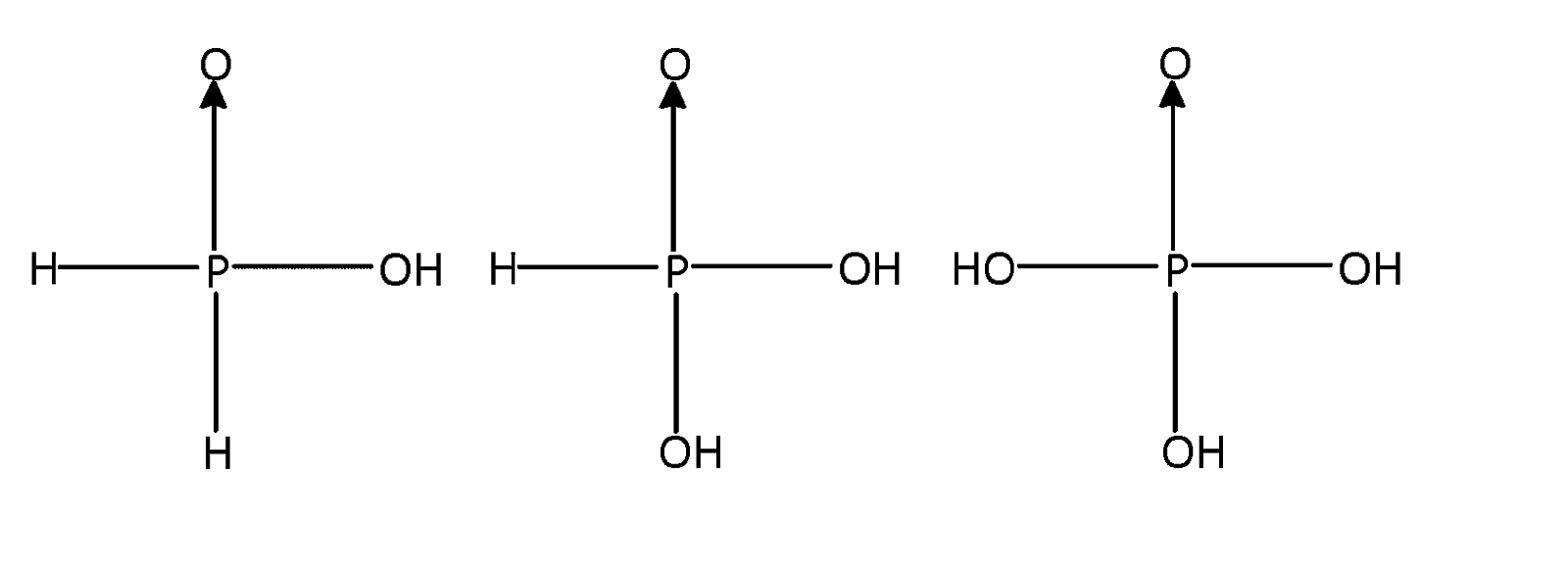
The true statement for the acids of phosphorus, ${H_3}P{O_2},{H_3}P{O_3}$ and ${H_3}P{O_4}$ is
A. The order of their acidity is ${H_3}P{O_2} > {H_3}P{O_3} > {H_3}P{O_4}$
B. All of them are reducing in nature
C. All of them are tribasic acids
D. The geometry of phosphorus is tetrahedral in all the three.
Answer
575.7k+ views
Hint: Phosphorous acid, is the compound described by the formula${H_3}P{O_3}$. This acid is diprotic, not triprotic. Phosphorous acid is an intermediate in the preparation of other phosphorus compounds. Organic derivatives of phosphorous acid, compounds with the formula $RP{O_3}{H_2}$ are called phosphoric acids.
Complete step by step answer:
${H_3}P{O_2},{\text{ }}{{\text{H}}_3}P{O_3}$ and ${H_3}P{O_4}$ are monobasic, dibasic and tribasic acids. The order of their acidity increases as the number of oxygen atoms increases, phosphorus acid is reducing agent, and has less oxidation property as $ + 5 $ oxidation state of phosphorus is more stable than $ + 3$.
${H_3}P{O_2},{H_3}P{O_5}$ and ${H_3}P{O_4}$ contain one, two and three ionisable hydrogen atoms respectively
But there is very little difference in acidity

As $s{p^3}$ hybridised all the above three phosphorus acids are tetrahedral

Phosphorus forms a number of oxoacids which differ in their structures and oxidation state of phosphorus atom liked tetrahedrally to four other atoms or groups each of them has at least one $P = 0$ or $P \to 0$ unit and one $P - OH$ unit. The OH group is ionisable but H – atom linked directly to P is non – ionisable structures of all the acids are considered to be derived either from phosphorus acid or phosphoric acid. The number of or $P = O$ and $P - O - H$ bonds in ${H_3}P{O_4}$ are $3$.
The correct option is (D), the geometry of phosphorus is tetrahedral in all the three.
Note:
Pure phosphoric acid is a white crystalline solid with melting point of $42.35^\circ C$. When it is less concentrated it is colourless, odourless, viscous liquid with a density of $1.885g/ml$. It is non – toxic and non – volatile. The most common phosphoric acid concentration is $85\% $ in water. Phosphoric acid is not considered toxic or hazardous. In low concentration it is safe on skin and even for consumption. However, at very high concentration it is corrosive and can cause skin burn.
Complete step by step answer:
${H_3}P{O_2},{\text{ }}{{\text{H}}_3}P{O_3}$ and ${H_3}P{O_4}$ are monobasic, dibasic and tribasic acids. The order of their acidity increases as the number of oxygen atoms increases, phosphorus acid is reducing agent, and has less oxidation property as $ + 5 $ oxidation state of phosphorus is more stable than $ + 3$.
${H_3}P{O_2},{H_3}P{O_5}$ and ${H_3}P{O_4}$ contain one, two and three ionisable hydrogen atoms respectively
But there is very little difference in acidity

As $s{p^3}$ hybridised all the above three phosphorus acids are tetrahedral

Phosphorus forms a number of oxoacids which differ in their structures and oxidation state of phosphorus atom liked tetrahedrally to four other atoms or groups each of them has at least one $P = 0$ or $P \to 0$ unit and one $P - OH$ unit. The OH group is ionisable but H – atom linked directly to P is non – ionisable structures of all the acids are considered to be derived either from phosphorus acid or phosphoric acid. The number of or $P = O$ and $P - O - H$ bonds in ${H_3}P{O_4}$ are $3$.
The correct option is (D), the geometry of phosphorus is tetrahedral in all the three.
Note:
Pure phosphoric acid is a white crystalline solid with melting point of $42.35^\circ C$. When it is less concentrated it is colourless, odourless, viscous liquid with a density of $1.885g/ml$. It is non – toxic and non – volatile. The most common phosphoric acid concentration is $85\% $ in water. Phosphoric acid is not considered toxic or hazardous. In low concentration it is safe on skin and even for consumption. However, at very high concentration it is corrosive and can cause skin burn.
Recently Updated Pages
Why are manures considered better than fertilizers class 11 biology CBSE

Find the coordinates of the midpoint of the line segment class 11 maths CBSE

Distinguish between static friction limiting friction class 11 physics CBSE

The Chairman of the constituent Assembly was A Jawaharlal class 11 social science CBSE

The first National Commission on Labour NCL submitted class 11 social science CBSE

Number of all subshell of n + l 7 is A 4 B 5 C 6 D class 11 chemistry CBSE

Trending doubts
Differentiate between an exothermic and an endothermic class 11 chemistry CBSE

10 examples of friction in our daily life

One Metric ton is equal to kg A 10000 B 1000 C 100 class 11 physics CBSE

Difference Between Prokaryotic Cells and Eukaryotic Cells

State the laws of reflection of light

Explain zero factorial class 11 maths CBSE




